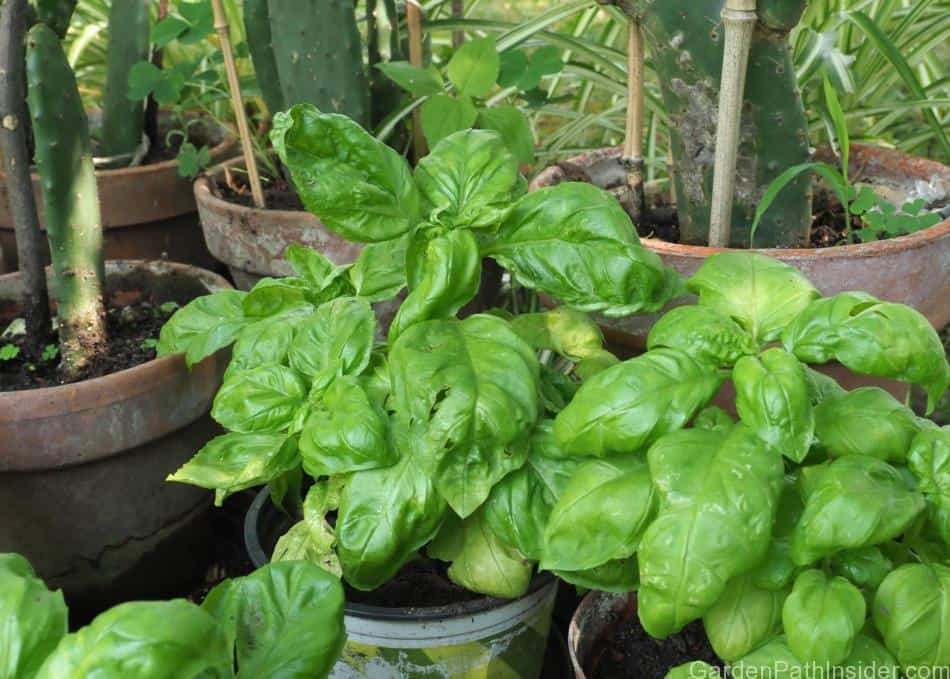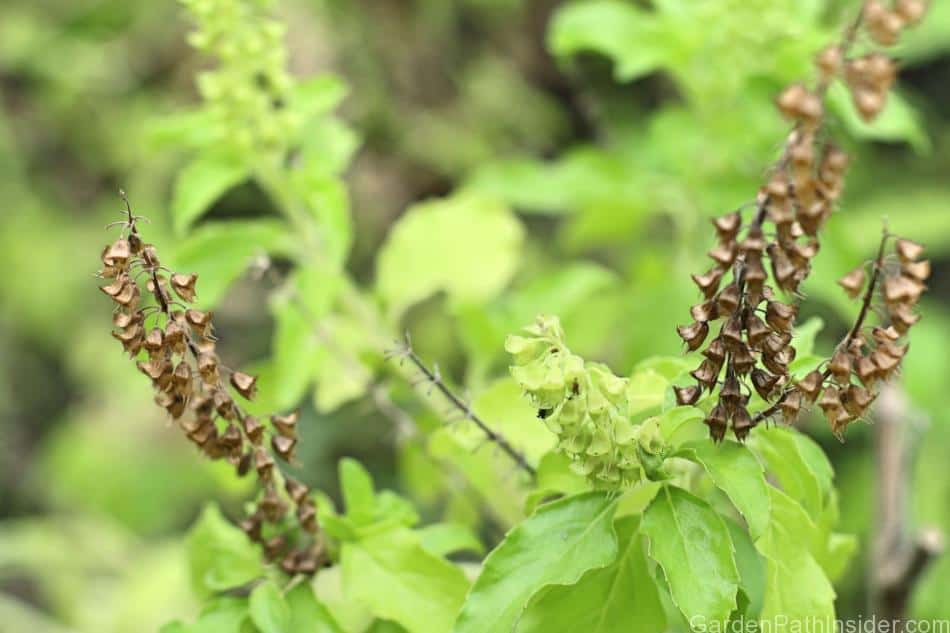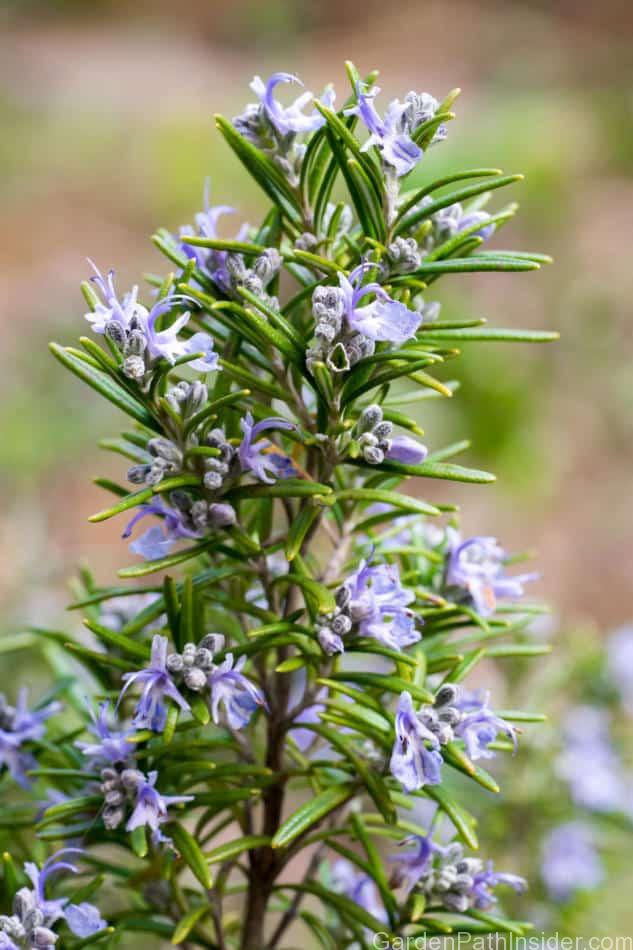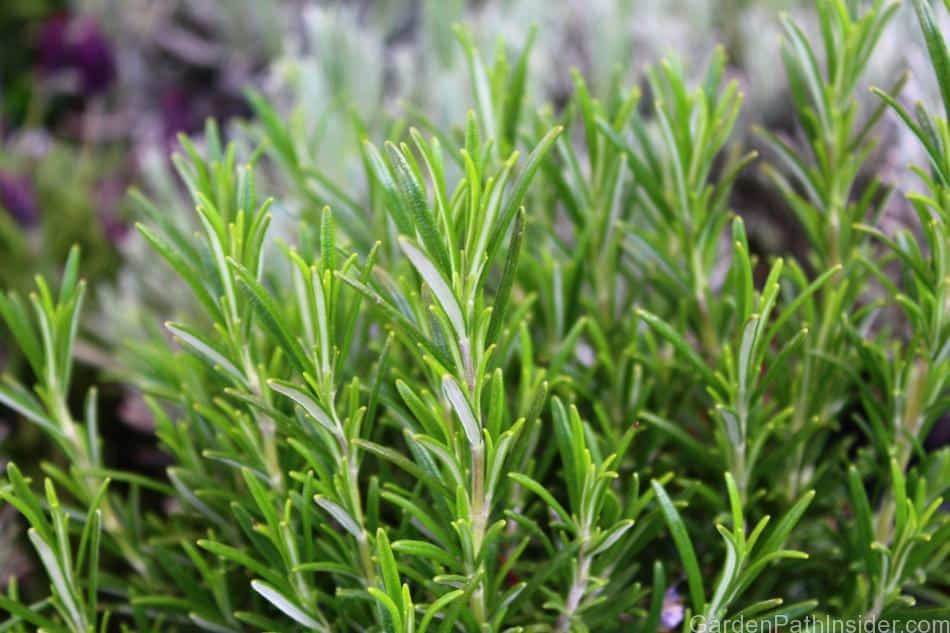
Fresh basil and rosemary are fragrant flavorful herbs that are easy to grow and enjoyed in many culinary dishes. As companion plants, basil and rosemary are great to grow side by side in your herb garden.
Basil and rosemary should not be planted together in the same growing container; as rosemary requires drier sandy soil, and basil requires moist fertile soil. Basil and rosemary are great companion plants to grow next to each other in separate growing spaces as rosemary can repel pests like aphids and moths that would damage tender basil leaves.
Growing basil and rosemary together is a great introduction to companion gardening. You can enjoy these fresh herbs in your kitchen year-round with the right materials and growing conditions!
Basil and Rosemary Companion Plantings
Basil and rosemary are companion plants and can help each other thrive when grown side by side. Rosemary contains strongly scented oils that act as a strong deterrent for several small insect pests like aphids and moths.
Basil and rosemary also require similar growing conditions for soil nutrients, and light needs per day; making both easy to care for together. We will cover these growing conditions below.
We strongly advise to not plant basil and rosemary in the same container or garden bed as basil requires significantly more water than rosemary. Basil may need to be watered several times per day in hot weather, rosemary is native to the dryer Mediterranean region. In its natural habitat, rosemary grows on the cliff sides next to the sea, and rosemary gets the majority of its water needs from the mist in the sea breeze.
Basil grows in clusters that can slowly spread through its growing space over the course of a growing season. If you are planting basil and rosemary in the same growing space, you can use a deep garden barrier planted between the plants to keep the rosemary soil drier than the wet basil side.
Garden bed barriers are long strips of metal or plastic buried just below the soil level to contain the spreading of plant roots. You can buy garden barriers online, at your local home store, or you can make your own with scrap materials you may have around the house.
Related article: Can Mint and Rosemary Be Planted Together?
Are you planting a kitchen herb garden? See our article resource on growing rosemary as a companion plant to mint. Rosemary is a wonderful herb that can be added to savory dishes like, chicken, pasta, and even topped on pizza crust. Read more here: Can Mint and Rosemary Be Planted Together?
Cover image details: Sweet basil plant (scientific name Ocimum basilicum)_© claudiodivizia/123rf.com

Basil Varieties
Basil is an annual that grows large tender leaves with a sweet refreshing flavor. Basil is used in many different dishes, from salads to savory pasta sauce. Basil grows about 36 inches tall (91cm) and blooms small flowers during the spring and summer.
Basil needs to be grown in warm day-time temperatures around 60°F to 70°F (15°C to 21°C), and night-time temperatures that stay above 45°F to 50°F (7°C to 10°C ).
Basil is not hardy enough to survive a frost or extended cold temperatures. Basil does spread slightly as it grows during the season. However, this plant will not take over garden beds with the same ferocity as mint.
There are several species of basil, each with unique flavors and fragrances. It is recommended to grow a single species of basil per pot, as growing several varieties of basil together in close proximity may cause cross-pollination. The cross-pollination will cause the species to blend together and the different varieties will lose their unique flavors as the cross-pollinated plants develop.
Below are some of our favorite Basil species to use in the kitchen:
- Sweet basil (Ocimum basilicum)
- Cinnamon basil (Ocimum basilicum Cinnamon)
- Lemon basil (Ocimum x africanum)
Sweet basil has a refreshing taste and is often paired with mozzarella cheese, tomatoes, and a balsamic vinaigrette for a quick and light meal. Our container garden often includes at least one variety of tomatoes in addition to our sweet basil.
If you are interested in expanding your container garden and would like to enjoy fresh produce year-round, read our article resource on growing tomatoes indoors year-round. In the article, we describe the path to a successful and fruitful indoor tomato garden. Read more here: Can You Grow Tomatoes Indoors Year-Round?
Rosemary Varieties
Rosemary is a tender perennial that can live for decades in warmer climates, though it is not hardy enough to withstand the winters of cold climates without wintering indoors or a greenhouse.
Rosemary varieties grow in either an erect upright shrub or a creeping variety that grows low to the ground more closely resembling ground cover.
To harvest rosemary, cut off sprigs of new green growth whenever the fresh herb is needed in the kitchen. The new growth is bright green, soft, and tender and is at the peak of flavor and fragrance. As the rosemary ages, the stems turn from soft and green to thick and woody. Pruning rosemary regularly will encourage the shrub to continue to develop new growth.
Rosemary’s unique fragrance and flavor are a wonderful addition to savory meals and treats, like soups, baked chicken, cheeses, and even ice cream.

Growing Requirements for Basil and Rosemary
Basil and rosemary will thrive in their own separate containers or garden beds. A single basil plant can spread quickly in any growing space it’s planted in. A single rosemary plant will grow into a large bushy shrub if not trimmed or pruned.
Basil: Container and Garden Bed Requirements
Basil is an easy herb to care for, as it can be grown in container gardens or garden beds. A single store-bought basil plant will spread in its growing space, though not invasively spread. Basil does not need to be grown in a large container or pot to thrive.
Basil does best in smaller containers that have less soil, as too much soil can hold excess water and drown the roots. A single basil plant will grow best in a pot that is 6 to 8 inches (15cm to 20cm) in diameter, and 6 to 8 inches deep (15cm to 20cm).
Rosemary: Container and Garden Bed Requirements
Rosemary can thrive in any size container. The height of the rosemary plant will be determined by the size of the growing space. If rosemary is planted in a small pot, then it will stay small. If rosemary is planted in the ground it can grow to several feet tall when properly pruned and maintained.
The key for growing basil and rosemary in containers is adequate drainage of the container. Clay pots usually have a large drainage hole in the bottom of the pot. Plastic containers may lack adequate drainage ports, though you can always add your own holes to the bottom of the container if needed.
Once you have holes in the bottom of your pots, add a few bits of broken clay pots or small rocks to keep the soil or roots from blocking the drainage ports. Adding a clay dish under the pot will contain any excess water.
If the plants are in small movable pots, you can always bring your plant to the sink and water it thoroughly letting the excess water drain out in the sink.
Soil Needs for Basil and Rosemary
Basil thrives in well-draining fertile soil. The soil should be loose enough to allow the small roots to easily spread and develop. If you have compost available, you can mix one-part compost with one-part topsoil for a great fertile growing medium for the basil plants. Store-bought soil works great for indoor gardens or container gardens.
Rosemary is native to the Mediterranean and thrives in sandy soil that is well-draining. If you are planting rosemary in a container or pot, use a sterile potting mix as backyard topsoil may contain bacteria or insects that could damage or contaminate your container garden.
Rosemary grown outside in a garden bed can be planted in sandy well-draining topsoil. For outdoor plants, I fertilize once a season with an organic fertilizer. Always follow the directions on fertilizers, as this step can negatively affect the garden if too much is used.

Water Needs for Basil and Rosemary
Basil Water Needs
Basil requires damp, slightly moist soil to thrive. Water daily as needed in normal weather, and water twice a day in the extreme summer heat. Basil is sensitive to drought, and the leaves will begin to shrivel as soon as the plant starts to get dehydrated.
To test the soil moisture press your finger in the soil a few inches away from the root system. Be careful not to press too deep, damaging the roots. Water when the soil feels like it is slightly dry to the touch. Too much water sitting in the roots can quickly kill a basil plant.
Pro Tip: Before you harvest basil make sure the plant has been watered thoroughly. Leaves on a well-watered basil plant will be plump, crisp, and tender; while leaves in a thirsty basil plant will be wilted, soft, and stringy.
Rosemary Water Needs
Rosemary is drought tolerant and thrives when only watered once or twice a week. In summer or warmer climates, check daily and water as needed.
Rosemary grown in potted containers is often overwatered. This is because the top of the soil may feel dry when there is still plenty of water deeper down in the root ball. Before watering rosemary look for the signs of dehydration.
Signs of dehydration in rosemary. When rosemary needs water the tops on the branches will start drooping over sideways and the soil will begin to pull away from the sides of the pot. When you see these signs it is time to water your rosemary plant.
Watering potted rosemary. When watering potted rosemary, you can bring the plant to a sink and water the pot thoroughly until the water is draining from the bottom of the pot. Leave the pot in the sink until water stops draining from the pot, then return the plant to its sunny growing space.
Watering in-ground rosemary. Rosemary planted inground is still susceptible to overwatering if the garden bed does not drain excess water well. To see if your plant needs water look to see if the new growth branches are drooping over. The established branches of rosemary will grow thick and woody and will not provide a good sign of the plant’s water levels.
If you have a backyard garden it may be worthwhile to invest in a soil moisture sensing meter or a T-handle soil sampler probe. Both tools will give you an accurate reading of your garden’s moisture levels and could save you from overwatering some of the more fragile plants in the garden.
Light Needs for Basil and Rosemary
Basil and rosemary both require full sun of 6 to 8 hours per day to fully thrive, though both plants will still grow satisfactory with less than full sun.
In warmer climates, plant basil in an area that gets sun in the first part of the day; with shade later in the afternoon when temperatures reach their peak.
Basil and rosemary grown indoors should be placed by windows that will get the full day’s sun. Avoid placing your container garden near heating elements like space heaters, ovens, or heating vents.
Basil is a perennial and will die off during the cold months of the season. In warmer climates, basil may return the following growing season if planted in a backyard.
Rosemary grows as a bushy hedge and will go dormant in the cold months of warmer climates. Rosemary will also go dormant in the cold months if it is grown indoors. Without full sun, rosemary will maintain its current size through the dormant period. Rosemary grown outside in cold climates will likely die and must be replanted each year.

When Can You Harvest Basil and Rosemary?
Harvest Basil
Basil leaves are best harvested once the plant has established its root system. Some varieties of basil can grow several feet tall, though most stay well below that.
To increase the number of leaves each basil plant grows, you can pinch off the new growth at the top of the plant once the plant reaches 8 to 12 inches (20cm to 30cm). Nipping the new growth at the top of the plant will cause the plant to grow bushy with more branches and leaves.
Pro tip: when harvesting leaves from basil and rosemary use a pair of scissors to snip the leaves off as close to the stem as possible. This will avoid tearing or damaging the branch of the fragile basil plant during harvest.
Harvest Rosemary
Rosemary can be harvested at any time once the plant has established its roots. To harvest rosemary, use a sharp pair of scissors to cut a sprig of rosemary off the plant at a node.
Once rosemary is established it is recommended to trim the plant throughout the growing season to encourage new growth on the branches.
The best parts of rosemary to harvest are sprigs of new growth, as the older growth on the plant will get thick and woody stems as the season progresses.
If you live in a warm climate the rosemary will survive through the winter with little effort needed to winterize the plant. In the pacific northwest, many backyard gardens have large healthy rosemary plants, as the winters are seldom cold enough to harm the plant. Even in this climate, there will be dead growth at the end of the season that needs to be cut back. Frequent removal of dead branches will benefit the plant’s ability to sprout new growth in the following season.
Below is a quick view summary of both basil and rosemary needs for your reference.
| Plant | Soil type | Water needs | Light needs | Bloom time | Harvest time |
| Basil | Loose well-draining fertile soil | Keep the soil slightly damp to moist. Water as needed. | Full sun | Summer | Basil leaves are edible at any time, though it’s best to wait until plants get at least 6 inches tall (15cm). |
| Rosemary | Drier sandy soil | Water the soil thoroughly once per week. Look for drooping branches and dry soil pulling away from the sides of the pot before you water. | Full sun | Depending on the variety, rosemary blooms can be spring/summer or fall/winter. | Rosemary can be harvested all season, as new growth develops on the plant. Frequent pruning of rosemary will allow the plant to continually produce new growth during the season. |
Looking to expand your herb garden but you’re running out of space? We have a solution for you. Growing lavender in hanging baskets is a great way to introduce the fragrant herb into a garden of any size.
Our resource article will guide you on the best ways to incorporate and maintain hanging lavender into your garden. Read more here: Can You Grow Lavender in Hanging Baskets?
